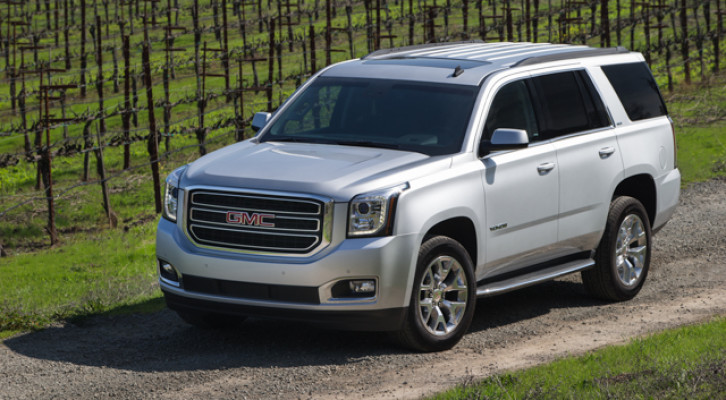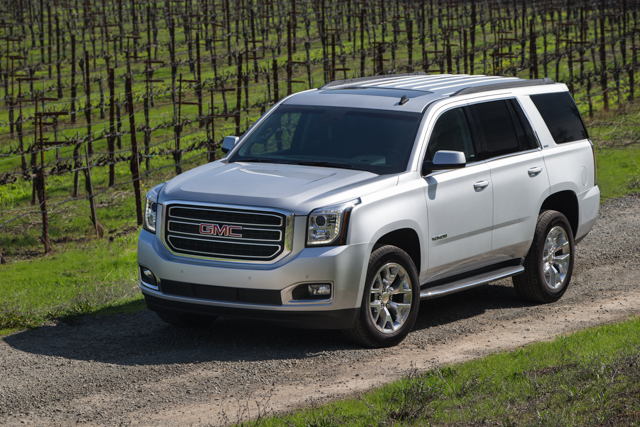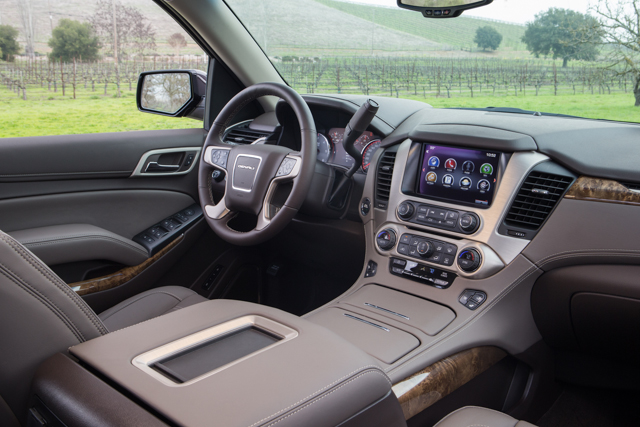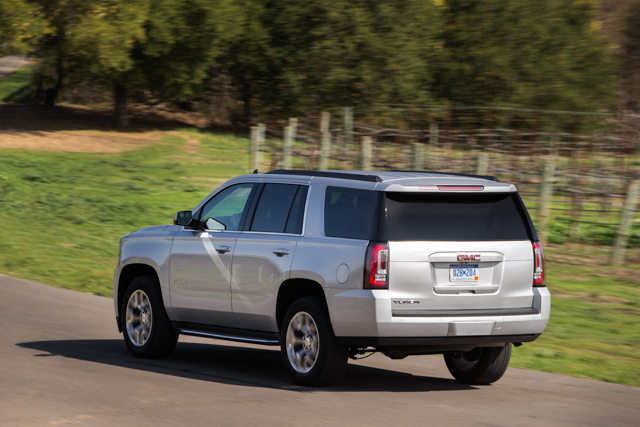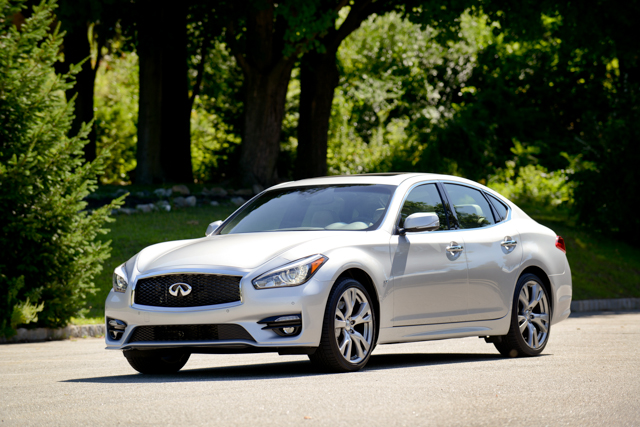A funny thing happened when I tried to compare the new GMC Yukon to its peers: it was awfully hard to think of any. The new Chevrolet Suburban and GMC Yukon aren’t actually the last of the giants, but full-size SUVs are a lot less common than they were ten years ago. The Ford Expedition has been so low-key as to be almost nonexistent for the past few years. The Nissan Armada is still kicking around, but it’s very close to the Titan pickup truck and much less civilized than even the previous-generation Yukon. And I had to think for a long, hard moment to remember if the Toyota Sequoia was still around (it is).
Compared to those vehicles, the GMC Yukon is positively high-profile. GMC and Chevrolet have never stopped pushing their big burly twins, keeping them fresh and updated, and the Yukon is all-new this year as an early-release 2015 model.
The future of full-size SUVs looks pretty good, at least if it’s got a GMC badge on it. The new Yukon is a brick-shaped hunk of future that manages to blend a lifetime of tough trucks with a modern, upscale look. It’s square, but the Yukon doesn’t scream “aerodynamic nightmare,” thanks to a tall, wind-tunnel carved shape. A blocky hood and massive grille are flanked by C-shaped LED character lights and headlights that seem to peel upward into the fenders. It’s square, but the shape of the bumper, lower fascia and grille seem designed to channel air up and around the big beast. Additionally, the doors have been redesigned to be flush with the body rather than wrapping up in to the roof (Trivia: these used be called “limousine-style” doors, and they let a lot of wind noise in on the freeway). These subtle but telling details help to give the Yukon a purposeful but distinctively attractive look. The creases down the slablike flanks may be hand-me-downs from Cadillac, but they work and the Yukon comes off as a strong vehicle that’s not too pretty to get dirty. The side mirrors are curiously small, but that’s my only aesthetic quibble.
The view from within is more businesslike, thanks to kinship with the Sierra pickup truck. The windshield is narrow, and makes the Yukon seem smaller than it is inside. A multi-cubbied console with a massive center storage unit is flanked by comfortable seats up front, while the businesslike dash includes full instrumentation. Integrated trailer brake controls serve as a reminder that the Yukon is a truck first and a suburban crawler second, while the low-mounted climate control unit is easy for driver and passenger to reach. Smaller storage compartments flank the console, which is also decorated with woodgrain trim that matches the dash and the French stitching that GM likes so much. There’s seating for up to seven in the Yukon’s three rows, and all of the rear seats fold at the touch of a button. With the seats folded, the Yukon will happily swallow a six-foot tall bookshelf. In fact, it’s almost embarrassing to use it for anything less than furniture; my weekly grocery trip looked ridiculous rattling around in the cargo hold, which can hold almost a hundred cubic feet of cargo with the seats folded.
The Yukon’s the sort of vehicle that will attract friends, not just because of its looks but because it’ll make you the go-to chauffeur for large groups. I didn’t mind. The third-row seats are respectably sized, and the second-row captain’s chairs are just as comfortable as the front seats. For even more space, the Yukon XL is still available, with just over a foot added to the wheelbase for more interior room.
For technophiles with newer phones than mine, the Yukon’s IntelliLink infotainment system can talk to the Siri personal assistant hiding in the iPhone. The new system will give text message alerts and Siri can read messages aloud to keep the driver’s eyes on the road. The Yukon’s OnStar system also functions as a built-in WiFi hotspot. Amenities like navigation, a rear-seat DVD player and power tailgate are of course available.
GMC’s big rig has a much more modern feel than any of the other big SUVs out there, and that’s thanks in part to the updated suspension, which sports coil-overs up front and a five-link mounting for the solid axle at the rear. The Yukon drives shockingly small, even with that massive hood stretching out in front, and if you’re not feeling confident a backup camera and blind spot monitor are available. Size creep over the years means that the Yukon is larger and taller than ever, but the relatively light reflexes and standard stability control keep it feeling manageable. Braking is respectable, and the big guy retains its composure in quick lane changes as well. All-wheel drive models have a slightly more ponderous feeling than rear-drivers.
The new Yukon is powered by an updated 5.3 liter V8. Here’s where it gives up a bit of the finesse that infuses the styling and suspension. In spite of the direct fuel injection and variable valve timing, the 355-horsepower 5.3 feels a bit overworked by this truck’s bulk, and acceleration was considerably less brisk than in past Yukons, or compared to the Nissan Armada. The tradeoff is improved fuel economy, of course. Aided by a cylinder deactivation system that I never noticed when it was operating, the Yukon’s 23mpg on the freeway is more than respectable for a truck this size–and that’s without an expensive hybrid system. Yukon buyers who want more power will have to step up to the high-luxury Denali model, whose exclusive 6.2 liter V8 throws down 420 horsepower. The standard six-speed automatic transmission is a bit slow to downshift on the freeway, so jockeying for position in heavy traffic can be a bit of an exercise in patience. On the upside, the 8500-pound towing capacity and a standard limited-slip rear differential mean the Yukon’s still a truck at heart.
For now, the Yukon can remain comfortably on the throne as the king of the giants. Ford’s got an update to the Expedition coming this year, though, and word has it there might be a new Toyota Sequoia on the way as well. That said, the Chevy Suburban and the Yukon (under a different name back in the day) were the first ones to sit down at the full-size SUV table, and it shows. Yukon pricing starts at $46,335, which is competitive with the Ford Expedition and Toyota Sequoia. Be careful with the options though; this truck’s bottom line adds up fast. With all-wheel drive and a range of options including a moonroof, fancy twenty-inch wheels, and a trailer-towing package, the Yukon I drove stickered for $65,515.

